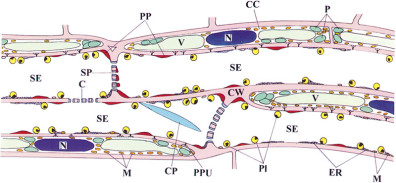The phloem consists of sieve elements, companion cells, phloem parenchyma cells and phloem fibers. Other cell types may be found in the phloem of certain plant species. The functional units for long distance translocation and signal distribution are sieve tubes. Sieve tubes consist of sieve elements which are elongated cells, connected to each other via sieve plates to form a continous tube system that spreads out through the entire plant. Sieve plates are end walls containing large pores to provide a connection between adjacent sieve elements (for more information on sieve plates see link on the left). In order to generate a tube system of low resistance, sieve elements loose most of their cellular components such as nucleus, cytoskeleton, ribosomes, tonoplast etc. during ontogeny. Mature sieve elements contain structural phloem specific proteins (P-proteins), mitochondria, ER, and sieve elements plastids. Other cellular structures of yet unknown function have recently been described (Froelich et al. 2011 ). Companinon cells derive from the same mother cell and remain in close connection with their sieve element. Since the sieve elements are incapable of self supported survival due to the lack of a nucleous and other organells, companion cells support their sieve element throughout its lifetime. Companion cells are characterized by a dense cytoplasm and a high number of mitochondria.

Schematic drawing of sieve tube structure in Vicia faba (broadbean). C, callose; CC, companion cell; CP, forisome; CW, cell wall; ER, endoplasmic reticulum; M, mitochondria; N, nucleus; P and Pl, plastids; PP, parietal protein; PPU, pore plasmodesma unit; SE, sieve element; SP, sieve plate; V, vacuole. From Knoblauch and Van Bel (1998) Sieve tuibes in action. Plant Cell 10, 35-50. Copyright American Society of Plant Biologists

Schematic drawing of sieve tube structure in Arabidopsis thaliana. C = chloroplast, Cl = clamp proteins, ER = endoplasmic reticulum, EV = electron dense vesicles, GM = ground matrix, M = mitochondrium, N = nucleus, P = plastid, SR = SEOR1 filaments, V = vacuole. From Froelich et al. 2011. Phloem ultrastructure and pressure flow: SEOR protein agglomerations do not affect translocation. Plant Cell . Plant Cell doi/10.1105/tpc.111.093179 Copyright American Society of Plant Biologists